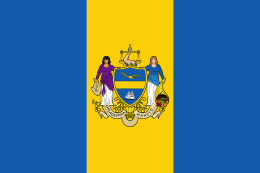Thomas Willing
| Thomas Willing | |
|---|---|
.jpg) Portrait by John Wollaston | |
| Born | December 19, 1731 |
| Died |
January 19, 1821 (aged 89) Philadelphia, Pennsylvania |
| Resting place | Christ Church Burial Ground, Philadelphia |
| Occupation | merchant, financier |
| Known for | Opposed the Declaration of Independence, president of Bank of North America, then Bank of the United States |
Thomas Willing (December 19, 1731 – January 19, 1821) was an American merchant, a Delegate to the Continental Congress from Pennsylvania and the first president of the First National Bank of the United States.[1]
Thomas Willing was born in Philadelphia, the son of Charles Willing, who twice served as mayor of Philadelphia, and Anne Shippen, granddaughter of Edward Shippen, who was the second mayor of Philadelphia. Thomas completed preparatory studies in Bath, England, then studied law in London at the Inner Temple. In 1749, he returned to Philadelphia, where he engaged in mercantile pursuits, in partnership with Robert Morris, until 1793.
Family
In 1763, Willing married Anne McCall. They had thirteen children. Their eldest daughter, Anne Willing, was a prominent socialite and married one of the richest men in America at that time, William Bingham. Another daughter, Mary Willing married Henry Clymer. Other daughters married William Jackson, Thomas Willing Francis (a cousin), and Richard Peters.
Political career
A member of the common council in 1755, he became an alderman in 1759, associate justice of the city court on October 2, 1759, and then justice of the court of common pleas February 28, 1761. Willing then became Mayor of Philadelphia in 1763. In 1767, the Pennsylvania Assembly, with Governor Thomas Penn's assent, had authorized a Supreme Court justice (always a lawyer) to sit with local justices of the peace (judges of county courts, but laymen) in a system of Nisi Prius courts. Governor Penn appointed two new Supreme Court justices, John Lawrence and Thomas Willing. Willing served until 1767, the last under the colonial government.[2]:52
A member of the committee of correspondence in 1774 and of the committee of safety in 1775, he served in the colonial house of representatives. As a member of the Continental Congress in 1775 and 1776, he voted against the Declaration of Independence. Later, however, he subscribed £5,000 to supply the revolutionary cause.

Banker
After the war, he became president of the Bank of North America (1781–91), preceding John Nixon, and then the first president of the Bank of the United States from 1791 to 1807. In August, 1807, he suffered a slight stroke, and he resigned for health reasons as president of the bank in November, 1807.[2]:189[3]
Willing died in 1821 in Philadelphia, where he is interred in Christ Church Burial Ground.[4]
See also
- Stephen Simpson (writer) Outspoken journalist and fierce critic of the First National Bank and its practices.
- List of wealthiest historical figures
- List of richest Americans in history
References
- ↑ "WILLING, Thomas, (1731–1821)". Biographical Information of the United States Congress. US Congress. 2009-06-11. Retrieved 2009-06-11.
- 1 2 Konkle, Burton Alva (1937). Thomas Willing and the First American Financial System. Philadelphia, PA: University of Pennsylvania Press.
- ↑ Wright, R. E. (1996). "Thomas Willing (1731-1821): Philadelphia Financier and Forgotten Founding Father". Pennsylvania History. 63 (4): 525–560. doi:10.2307/27773931 (inactive 2015-02-10). JSTOR 27773931.
- ↑ Thomas Willing at Find a Grave
- Wright, Robert E. "Thomas Willing (1731–1821): Philadelphia Financier and Forgotten Founding Father". Pennsylvania History, 63 (Autumn 1996): 525–60.
- United States Congress. "Thomas Willing (id: W000556)". Biographical Directory of the United States Congress.
- Columbia Encyclopedia article
External links
- Biographical sketch and portrait at the University of Pennsylvania
- The Willings and Francis Records, including correspondence, deeds and legal documents of Thomas Willings' mercantile firm (Willings and Francis), are available for research use at the Historical Society of Pennsylvania.
| Preceded by Henry Harrison (mayor) |
Mayor of Philadelphia 1763–1764 |
Succeeded by Thomas Lawrence (II) |
